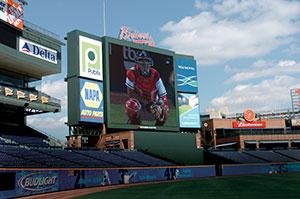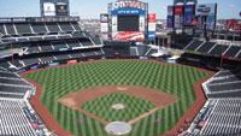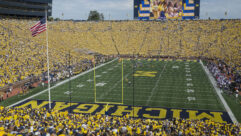

Stadium AV: Mine’s Bigger Than Yours
When it was completed just before the start of the Atlanta Braves’ 2005 baseball season, Turner Field’s $10 million, 71-foot-tall, 79-foot-wide LED screen made the Guinness Book of World Records as the largest high-definition display ever made. Of course, this being the Steroid Era in pro sports, Turner Field’s benchmark didn’t last long.
A mere three years ago, Turner Field in Atlanta sported the biggest HD display in the world. That didn’t last long.
When it was completed just before the start of the Atlanta Braves’ 2005 baseball season, Turner Field’s $10 million, 71-foot-tall, 79-foot-wide LED screen made the Guinness Book of World Records as the largest high-definition display ever made. Of course, this being the Steroid Era in pro sports, Turner Field’s benchmark, established by the Warrendale, Pa.–based Diamond Vision unit of Mitsubishi Electric, didn’t last long.
Daktronics—the fully juiced leader of the sports video-display business, controlling about two-thirds of the U.S. high school and college market, as well as much of the international space—would soon break the record by installing two giant 720p LED boards at Miami’s Dolphin Stadium, one measuring 137 feet by 50 feet. The Brookings, S.D.–based company broke its own mark just days later when it completed a slightly more gigantic $8 million, 134-foot-by-55-foot board in Austin, Texas, for the Darrell K. Royal Texas Memorial Stadium, which Texas Longhorn football players quickly took to calling “The Godzillatron.”
Now, everybody knows Godzilla is from Japan, so perhaps it was fitting that Mitsubishi would rally back into the record books by building and installing a 218-foot-by-37-foot, 8,066-square-foot monster for horse-racing’s Tokyo Race Course. Reported price tag: $28 million.
And on and on the race has gone. Daktronics took back the throne this past April, completing the new 85-foot-wide, 106-foot-tall CrownVision HD LED display for the Kansas City Royals’ Kauffman Stadium. While in September, Mitsubishi will set about shattering the benchmark once again as it begins work on a four-sided, rectangular LED scoreboard that will hang from the roof of the Dallas Cowboys’ new gridiron home. Spanning from one 20-yard line to the other and hanging 110 feet above the playing field, the massive structure’s long sides will feature 1080p, 20mm-pitch displays that are 160 feet wide and 72 feet tall.
Just opened this spring, the new Nationals Park in Washington, D.C., has 450 EAW MK Series loudspeakers and a Mitsubishi-built LED display measuring 47 feet by 101 feet. Plus it features 700 feet of fascia. Not pictured are the LED diodes bedazzling 2,600 square feet of outfield wall.
Credit: Courtesy EAW
When the Cowboys’ AV behemoth is completed in the spring of 2009, “It will be the largest HD display in the world. It will take multiple synchronized controllers just to run it,” says Mark Foster, general manager of Mitsubishi’s Diamond Vision Systems Group. “It’s a challenge for us. Not only do we have to make a big, center-hung display look good to the crowd at multiple viewing angles, it has to meet certain weight limitations, and it has to be reliable, because getting up there to service those screens is going to be hard.”
‘IT’S A PRIDE THING’
The idea for the display originated from Cowboys’ owner Jerry Jones, who had earlier been impressed by the 34-foot-by-110-foot LED backdrop that Mitsubishi put together for a Celine Dion concert in Las Vegas. “He said he wasn’t sure what he was looking at, but that’s what he wanted,” Foster notes. “That’s how we became involved in the project.”
“We see this ‘keeping up with the Joneses’ thing right down to the high school level,” says Mark Steinkamp, marketing and sales support manager for Daktronics. And by “Joneses,” he’s not just referring to ostentatious team owners who demand the latest and greatest in AV technology—the manufacturers, integrators, and consultants are plenty eager to tout their work, too.
“It’s a pride thing,” Steinkamp say.
“There’s always a little bit of one-upsmanship going on,” agrees Bradford Benn, business development manager for Elkhart, Ind.–based Crown International, which recently partnered with Kenilworth, N.J.–based Diversified Systems to build a $300,000 audio amplification system in the Prudential Center, the $375 million new home of the NHL’s New Jersey Devils and the Seton Hall Pirates men’s NCAA basketball team in Newark, N.J.
Working under a plan laid out by Dallas-based Wrightson, Johnson, Haddon & Williams (WJHW), the leading AV design consultancy in the pro sports biz, Diversified built the arena sound system around 126 Crown I-Tech and CT Series amplifiers rack-mounted together on a catwalk platform, as well as an array of speaker clusters manufactured by Crown corporate siblings JBL.
Not quite the size of a football field, the mid-field display at the new home of the Dallas Cowboys will span from 20-yard line to 20-yard line and hang 110 feet above the field. The stadium is expected to be completed in spring 2009.
Credit: Courtesy Mitsubishi Electric
In Washington, D.C., Crown worked with AVI-SPL, a leading integrator in pro sports AV based in Tampa, Fla., to install a $250,000 amplification system in the Washington Nationals’ new ballpark, among a number of other sports venue projects.
For pro teams, advanced AV products have become a vital draw in an era in which they’re competing with an increasing number of other entertainment options to fill seats. Big display systems—as well as other ubiquitous LED products, such as ribbon boarding—also offer teams a way of expanding their advertising revenue amid spiraling player contracts.
For the AV contractors that service these clients—a small, elite group of LED display builders, audio component manufacturers, AV systems integrators, and electrical engineering consultants—big pro sports venues represent a modest business. Perhaps far more significant to them is the brand marketing opportunity they represent.
“Overall, it’s not a huge part of our business,” adds Foster, who estimates that the entire sports-venue large-screen display business yields revenue of about “a couple hundred million dollars” in the U.S. annually. “However, it is a very visible part of our business. Everyone who’s in the ballpark can see and appreciate the quality of the product.”
Benn agrees. “It’s still the medium and smaller venues that make up the majority of our revenue stream, but this is certainly a very visible portion of our business,” he says. “In terms of marketing, we definitely try to leverage this any way we can,” Benn adds, noting the press releases Crown issues to tout big sports projects like the Prudential Center.
For their part, on high-profile projects such as these, AV integrators say they really don’t need press releases. “Historically, we haven’t actively marketed what we do because what we do is so high-profile, it markets itself,” says Justo Gutierrez, AVI-SPL’s engineering manager.
Gutierrez points to AVI-SPL’s involvement on the Nationals’ audio install, a project he says was notable for its use of a Yamaha M7-CL48 digital audio mixing console—it was the first stadium project the firm has done in which the audio mixing was digital from the console on out. As for touting the work, Gutierrez adds, “The Washington Nationals will do as much marketing as anyone else for it.”
Credit: Courtesy Mitsubishi Electric
And as for any one-upsmanship, he ascribes that to the manufacturers and design consultants who try to push these projects to the next level of technological flash. Sony, for instance, played a major role in the Nationals’ design and is making a push into stadium integration services.
PICK YOUR SPOTS FOR FLASHY
For his part, Brian Elwell, senior consultant for Acoustic Dimensions, an AV design firm based in Dallas with a significant pro sports venue portfolio, concedes that there is an emphasis on memorable communications technology. However, he notes that system designers need to pick and choose what components to be flashy with.
“You want to bump up the technology so that the ticket holder is really going to see it, but that’s not to say that every piece of the system is going to be the latest technology,” he explains. “I think you have to strategize where you’re going to invest so that you create the impression of being a high-tech facility without completely going crazy with the technical budget. If you sat down and chose the latest and greatest in every area, the amount of money you’d spend would be astronomical.”
On the display side, the sports AV market is not only expanding on account of the proliferation of new arenas and stadiums, but also due to reverb from the LED revolution that began about a decade ago.
ANGLES IN THE OUTFIELD
Credit: Courtesy Martin Audio
Tricked out with 450 EAW MK Series loudspeakers, a massive $250,000 Crown Audio amplifier stack, and an all-digital Yamaha-based mixing system, Washington, D.C.’s new 41,888-seat Nationals Park is one of Major League Baseball’s premiere ballparks when it comes to audio support.
But even sports venues with the latest and greatest technology face challenges when they attempt to program non-sports-related activities.
Indeed, when Pope Benedict XVI scheduled a mass at Nationals Park on April 17 as part of his recent North American visit, the event’s producers had an acoustical challenge on their hands that would vex any ballpark, no matter how good the sound system.
The mass was configured with the stage fixed close and parallel to the centerfield wall, facing out to an outfield that would seat hundreds of the 47,000 faithful who would attend the event, not to mention a choir and numerous other interested parties.
If the stage had been positioned in the middle of the field, say between second and third base, the angle of the native EAW loudspeakers rimming the perimeter of the venue would have been just fine—there wouldn’t have been a delay problem for those situated on the field, because they’d be positioned pretty much in equal distance to all the speakers.
“We couldn’t use the existing audio system because, as with all stadiums, the sound comes from above and behind the audience,” says Mike Scarfe, owner of Hagerstown, Md., integrator MHA Audio, which was contracted by event-production company Showcall of Halethorpe, Md.
“Since the stage for the Papal Mass was at one end, it would have been impossible to time-align [the native audio system] to the stage.
“Basically, we had a 550-foot throw from the speaker tower to the farthest seat,” adds Scarfe, who worked with U.K.-based manufacturer Martin Audio to acoustically map the venue in the company’s own Display predictive software in order to determine the proper angle for line-array speakers.
Ultimately, MHA designed a scheme built around two 60-foot steel towers flanking the stage. The total speaker array included 32 Martin Audio W8L Longbow cabinets, 30 Martin W8LC speakers, six Martin WSX subwoofers, and two Martin WT3 enclosures.
“We thought the best thing to do was have the sound come from one place,” Scarfe explains.
“It wasn’t just about clear spoken-word reproduction,” he adds, “because on stage right behind the speaker tower, we had a 700-member choir and an orchestra of 50. The program started at 5 a.m. once the gates were opened and there was a variety of entertainment including notable opera singers Placido Domingo and Denyce Graves up to the start of the mass at 10 a.m.”
With their components exposed to sun and rain and technological advancement, a number of legacy pro sports venues have begun to swap out older standard-definition LED displays for bigger, better state-of-the-art HD boards.
This movement, of course, is also being pushed along by the same driver affecting many other vertical AV markets—the simple fact that most consumers now experience HD video at home, and certainly expect it when they pay to go out for entertainment.
“High-definition is definitely the biggest driver at the high end of the market,” says Steinkamp of Daktronics, which in addition to designing and building large-venue LED displays, runs a video and animation group to help program them. “Teams need to compete with the living room.”
“We probably have six to 10 sports venues on our books at any given time, ranging from Major League Soccer to Major League Baseball, and for me, it all seems to be driven by the world of video,” adds Elwell. “With the changeover to the digital standard for broadcasters and the overall movement to high-definition, we’re quickly seeing lots of these facilities switch over.”
Driving market growth just as much is knowledge among sports venue operators that the more LED footage their stadiums feature, the more advertising they can support.
The new Dallas Cowboys stadium will feature 3,600 linear feet of Diamond Vision LED fascia lining two levels, for example. Meanwhile, in addition to a Mitsubishi-built LED display measuring 47 feet by 101 feet, Nationals Park features 700 feet of fascia, as well as LED diodes that cover 2,600 square feet of the outfield wall.
Indeed, among stadium marketers, the big buzz term these days is “moment of exclusivity”—that is, offering a sponsor the ability to dominate every visual in the house at any select moment in time.
“Today, when they go into a stadium environment, sponsors demand exclusivity,” Foster says. “And with digital signage, we can put Coke or Pepsi’s name on every sign in the building at the same time. Sponsors love that. They really feel like they’re getting value.”
GETTING IN THE GAME
For AV integrators growing in size and stature, and wishing to get into the sports AV game at its highest ebb, entry doesn’t come easy.
“Typically, the bid lists are limited because the general contractors want to limit their liability,” notes AVI-SPL’s Gutierrez. “We’ve done [the audio] in six of the last seven Major League Baseball projects, for example. And usually, you end up with only three [AV] contractors for a completed system.”
Like it is in most markets, a toehold is usually acquired through connections to the elite group of general contractors, consultants, and manufacturers that run this end of the business. For those without a vast sports venue portfolio, initial entry can also be gained by walking the tightrope of narrow profit margins.
Gutierrez says his firm typically shoots for a margin of about 15 percent on big pro-sports projects, which can grow to as big as $20 million for an NFL venue in a large city that requires the employment of subcontracted electrical work and union labor.
Credit: Courtesy Mitsubishi Electric
Newer entrants should expect less than 15 percent.
“We tend to sell ourselves on our engineering savvy and experience, but just as any situation involving public money, low bids tend to carry the day,” he explains. “We do see smaller integrators take on lower margins and win the job.”
Of course, lack of experience combined with narrow margins yields sizable risks. “You can’t make money in this business unless you bid the job smartly,” Gutierrez notes. “And there have been times when we’ve walked away because a bid fell below a certain threshold.”
Indeed, it isn’t all about who has the biggest screen or the most amps.
“We do these projects with the aim to make money,” adds Crown’s Benn. “Everyone does their first one for the prestige, then they realize that they still have to pay the bills.”
Daniel Frankel is a freelance writer in Los Angeles. He can be reached at [email protected].










